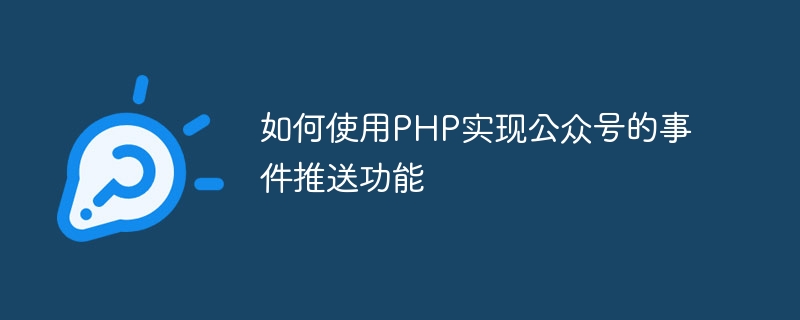Home >Backend Development >PHP Tutorial >How to use PHP to implement the event push function of public accounts
How to use PHP to implement the event push function of public accounts
- 王林Original
- 2023-09-21 14:01:032265browse

How to use PHP to implement the event push function of public accounts
In today's social media era, WeChat public accounts have become an important way for enterprises to communicate and promote with users One of the platforms. The event push function of official accounts is the basis for realizing important functions such as interaction with users and automatic replies. This article will introduce how to use PHP language to implement the event push function of WeChat official account and provide specific code examples.
1. Preliminary preparation
Before starting, you need to ensure that the following conditions are met:
- Have registered a WeChat public account and completed basic configuration;
- The developer ID (AppID) and developer key (AppSecret) of the WeChat public platform have been obtained;
- The server environment has been configured to support PHP operation and relevant permissions to access the network.
2. Receive and process event push
- First, enable the event push reception function in the background of the official account, and set the server address to the URL for receiving the push. The receiving URL can be set in the "Development-Basic Configuration" in the backend of the official account.
- In PHP code, use the $_POST global variable to receive event push data POST from the WeChat server to ensure data security. The sample code is as follows:
$postData = file_get_contents("php://input");
$postObj = simplexml_load_string($postData, 'SimpleXMLElement', LIBXML_NOCDATA);- Next, different processing is performed based on the event type received. Common event types include:
- Subscription events (subscribe): events triggered by users following official accounts.
- Unsubscribe event (unsubscribe): An event triggered by the user unfollowing the official account.
- Custom menu click event (CLICK): an event triggered by the user clicking on the custom menu.
Carry out corresponding processing logic according to different event types. The sample code is as follows:
if ($postObj->MsgType == 'event') {
if ($postObj->Event == 'subscribe') {
// 订阅事件处理逻辑
} elseif ($postObj->Event == 'unsubscribe') {
// 取消订阅事件处理逻辑
} elseif ($postObj->Event == 'CLICK') {
// 自定义菜单点击事件处理逻辑
}
}3. Reply message
During the processing of event push, we usually need to reply to the user with a message. WeChat official accounts support multiple types of message replies, including text messages, graphic messages, etc. The following is a sample code for a simple text message reply:
function replyText($toUser, $fromUser, $content) {
$template = '<xml>
<ToUserName><![CDATA[%s]]></ToUserName>
<FromUserName><![CDATA[%s]]></FromUserName>
<CreateTime>%s</CreateTime>
<MsgType><![CDATA[text]]></MsgType>
<Content><![CDATA[%s]]></Content>
</xml>';
$result = sprintf($template, $toUser, $fromUser, time(), $content);
echo $result;
}
// 使用示例
replyText($postObj->FromUserName, $postObj->ToUserName, '欢迎关注我们的公众号!');In actual applications, according to business needs, customized message replies can be made based on different event types and message types.
4. Signature Verification
Before receiving message push from the WeChat server, signature verification is required to ensure that the request comes from the WeChat server and not other malicious requests. For the specific signature verification process, please refer to the WeChat public account development documentation.
Summary
Using PHP to implement the event push function of WeChat official accounts is relatively simple. It only requires a few steps to receive and process event push, reply to messages, etc. Through the code examples provided in this article, I believe readers can quickly implement their own official account event push function.
The above is the detailed content of How to use PHP to implement the event push function of public accounts. For more information, please follow other related articles on the PHP Chinese website!

